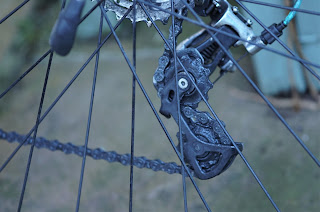I’m a big fan of dynamos and hub
dynamos specifically and there’s something incredibly satisfying about navigating
by your own, high-quality lighting. I’ve run hub dynamos since 2001, when I
went for a Shimano Nexus unit which, by contemporary standards produced huge
amounts of resistance. Fine for commuting and using a “seen by” lamp-I’d run it
with Ursula for a while but an Ultegra unit and 800lumen Exposure Revo were
literally light years ahead.
I’m still very fond of the
Shutter Precision hubs HALO
EVURA & SHUTTER PRECISION SL9 DYNOHUB BUILD, which are light,
well-executed and very smooth. My one gripe is the need for them to be sent
back to the factory for bearing replacement. I’ve consistently returned
20,000miles from the sealed cartridge bearings- typically three years, so the
hub and cost of wheel building is perfectly economic-repaid their investment. However,
my preference is for something at least partially user-serviceable, especially consumables,
such as bearings, which by definition are bound to wear out.
Shimano is the obvious option. I’d
contemplated a Kaisai unit, which are user serviceable and make a lot of sense
for arse end of nowhere touring (not that I’d want an expired hub dynamo, or
any other component anywhere). Neds to be disc compatible-ideally centre lock. I’ve
had the Halo/SL9 wheel trued and will run that as the spare for now.
Temperatures have been consistently high here in the UK. I’m not remotely
surprised since 2025 was projected to be the hottest on record and further evidence
of climate change.
I’m favouring jerseys and other
clothing with high factor SPF yarns, sometimes long sleeves, such as this
Cycology Men’s Summit Long Sleeve Jersey Cycology
Men’s Summit Lightweight Summer | cycling-not-racing or indeed, this
Funkier Ixara Gents Elite Jersey Funkier
Ixara Gents Elite Jersey | cycling-not-racing . A fully laden, frozen back
bottle TESTED:
BACK BOTTLE CYCLING WATER BOTTLE is another really useful cooling aid for
hotter rides. Glasses with UVA & B protection and photochromic lenses are
another default. Well-ventilated
footwear and decent socks shouldn’t be overlooked either. I’ll never forget the
summer of 1992 and some badly burned soles, courtesy of black patent road shoes
and long miles along molten roads.
Coupled with cheap polyester
socks and a basic nylon sole proved a recipe for painfully blistered feet.
While they had a decent amount of float, I don't miss hobbling/waddling around
sans bike, not to mention gouging chunks out of expensive lino. Still, they
were what might be termed an aspirational purchase, plucked from the sale bin
at a frequent local haunt- all 18-year-old me could afford at the time and they
served surprisingly well. There was and to some extent is something very
romantic about that era and indeed, getting a bargain but those years are also
tinged with painful regrets in other areas of life, regrets that are etched
deep, even now. We cannot change the past, only our relationship to it,
or indeed, them.
Three decades plus, I’ve gone
over to the stiffer soled FLR F70 Prop MTB M250 FLR F70 Pro
MTB M250 Shoe | cycling-not-racing which I my experience, give a little more efficiency
aboard Muffin, which is palpable on the climbs-remember, honking might be
vulgar on a tourer, or gravel build but perfectly acceptable on the fixed. Saddleback,
the UK’s Sidi distributor thoughtfully sent me these Sidi Aertis MTB shoes,
which promise a blend of efficiency, with sufficient give in the sole for navigating
the trail sans bike or just plodding about mid-ride.
Theoretically extending their
horizons to bike packing, touring, cyclo cross and indeed, winter training. The latter duties are amplified further by the
toe studs. The soles are made from Nylon and employ specialist polyurethane
inserts for comfort. Some would argue in favour of carbon at this price point.
However, carbon tends to limit walking or running prowess and can be a little
too stiff on longer rides, so arguably an engineered choice, rather than a cost
cutting exercise.
I’d forgotten how good the Maxxis Roamer TESTED : MAXXIS
ROAMER TYRES are, especially along poorly surfaced lanes, while still being
fairly swift. Be interesting to see how they compare longer term, with the
Continental Pure Contact, which remains (and will stay) at the rear, since they
are proving very dependable, compliant and again, relatively swift for big
volume rubber. Elsewhere, a bearing strip and re-grease of
the Shimano XT pedals led me to resurrecting these original SPD from 1990.
Still buttery smooth and so glad I’ve held on to them. I also switched Denise’s Ergon All Road Core Comp Ergon
SR All Road Core Comp Saddle Men | cycling-not-racing back to the Pro
Turnix Gel, since I’d been experiencing some chafing along my inner right thigh.














































